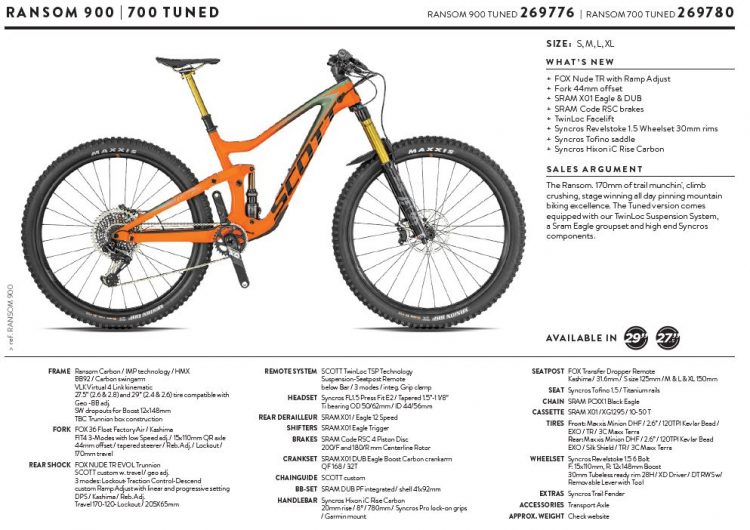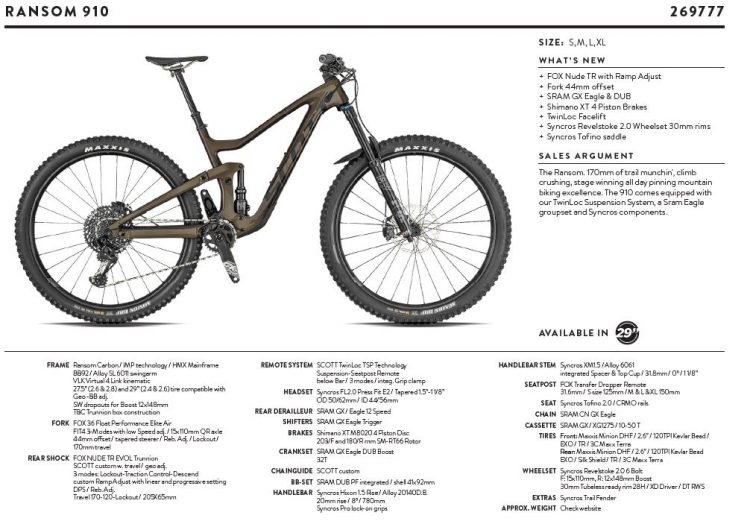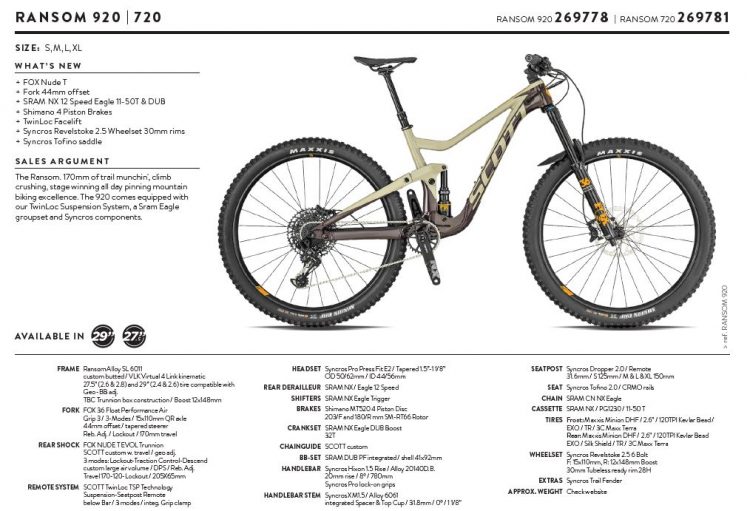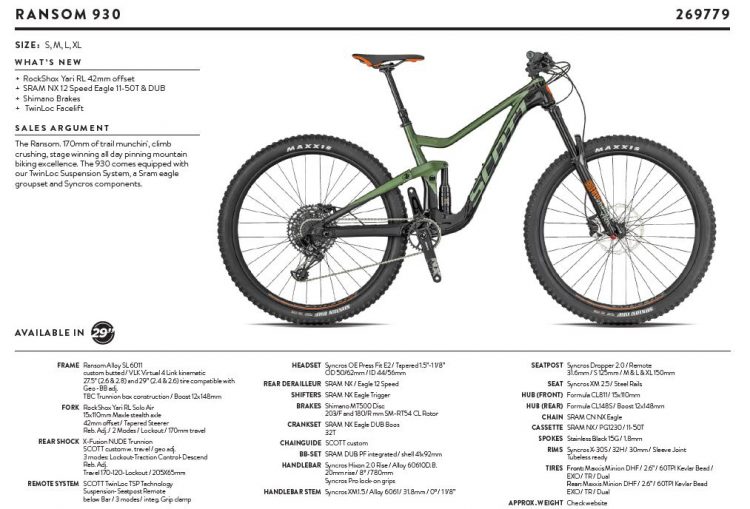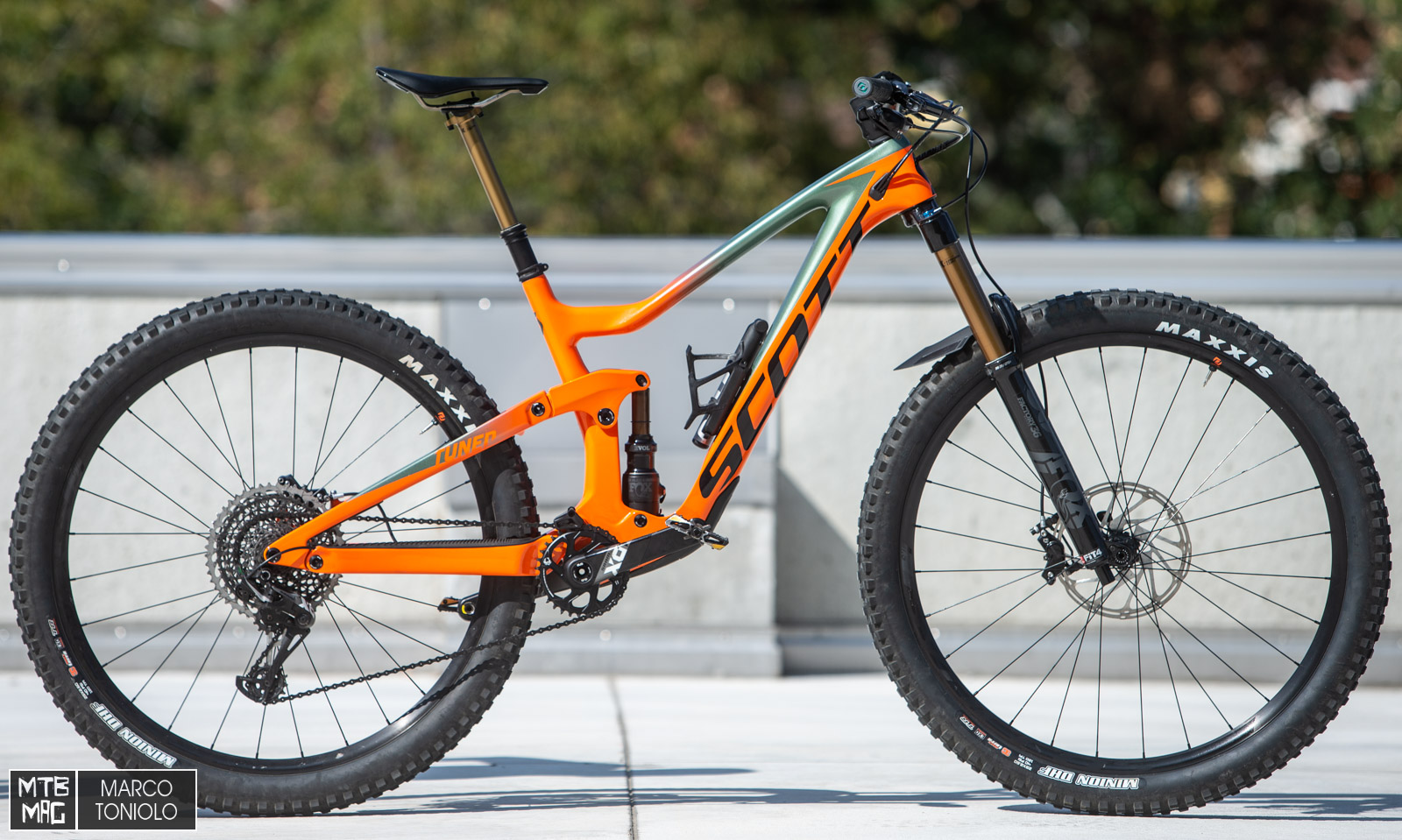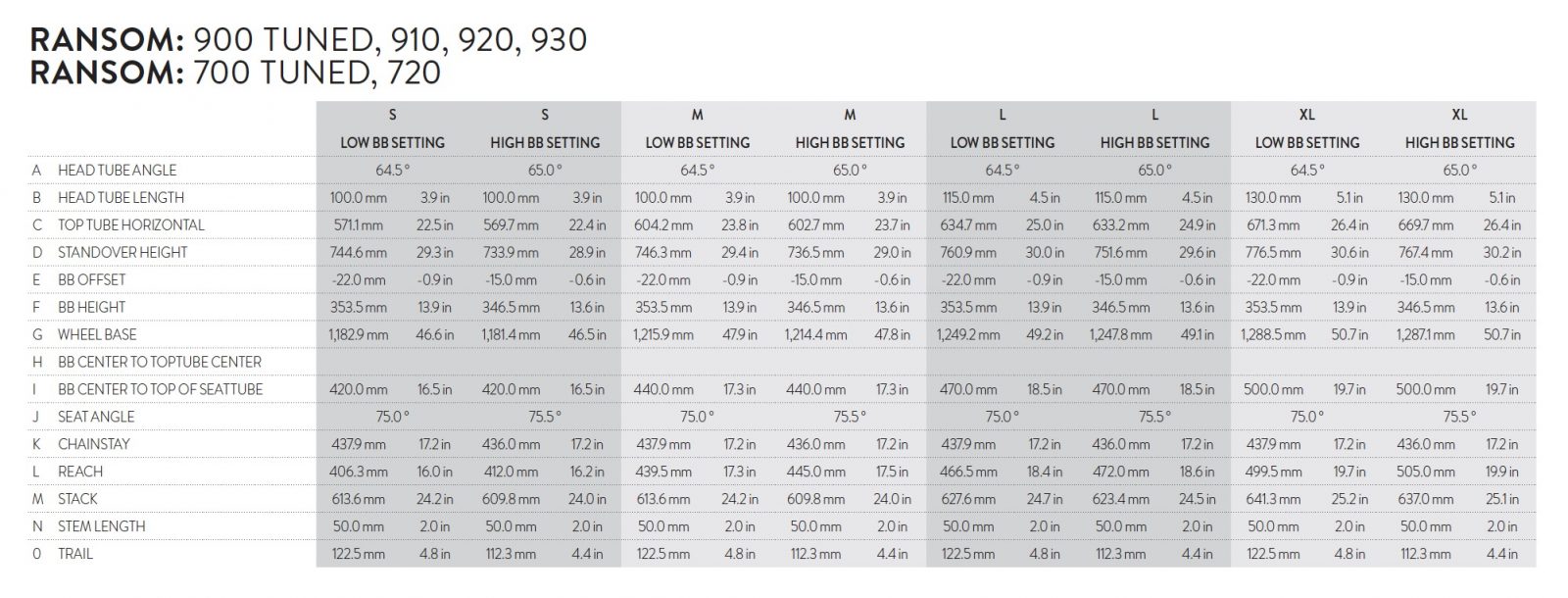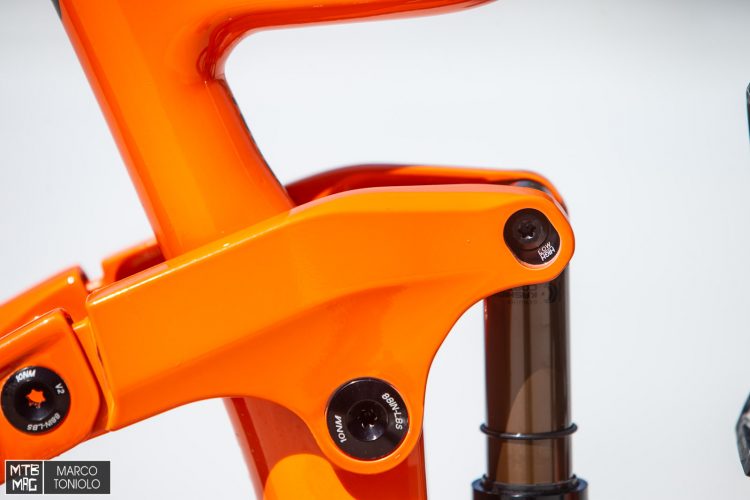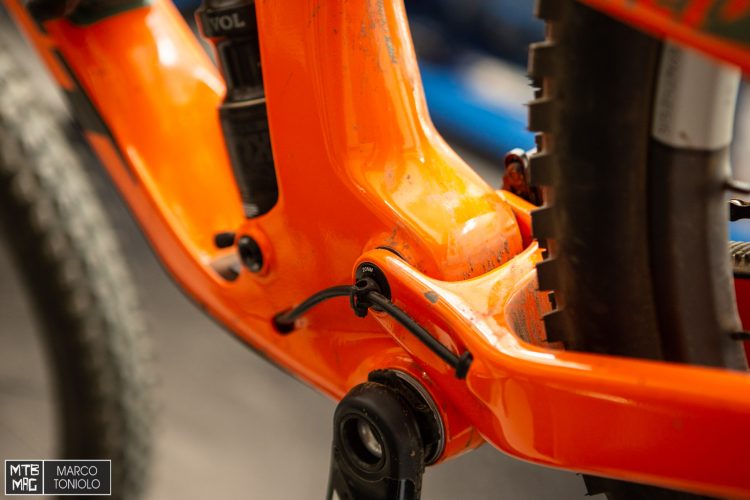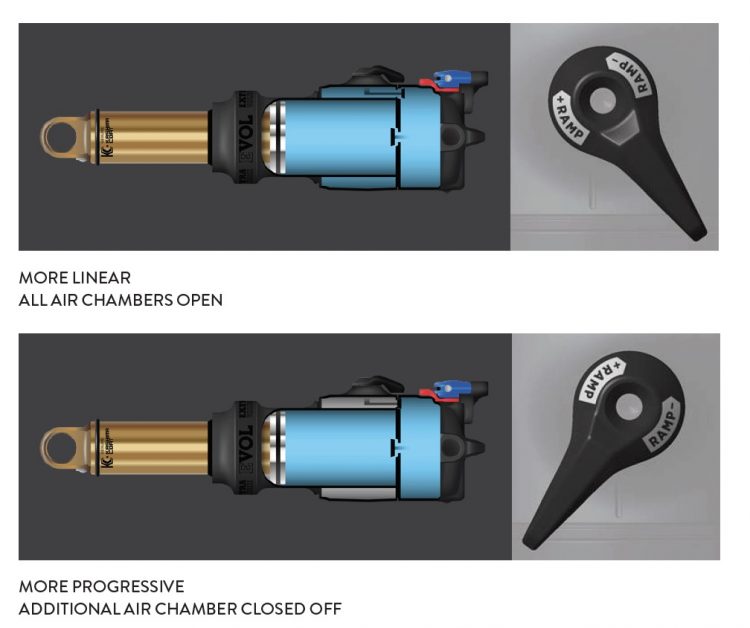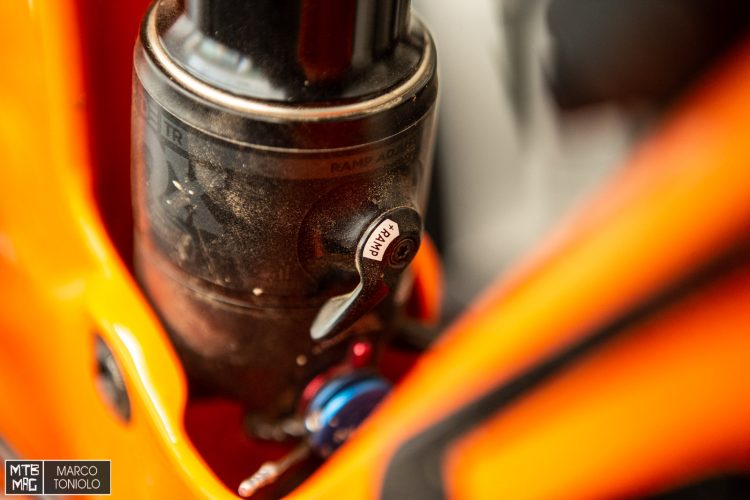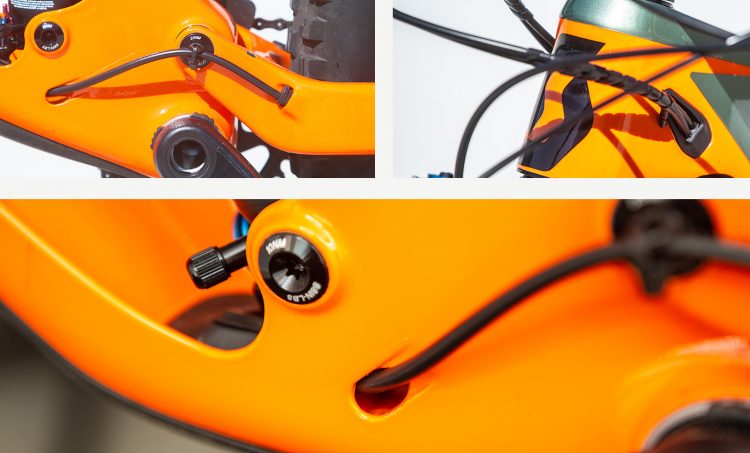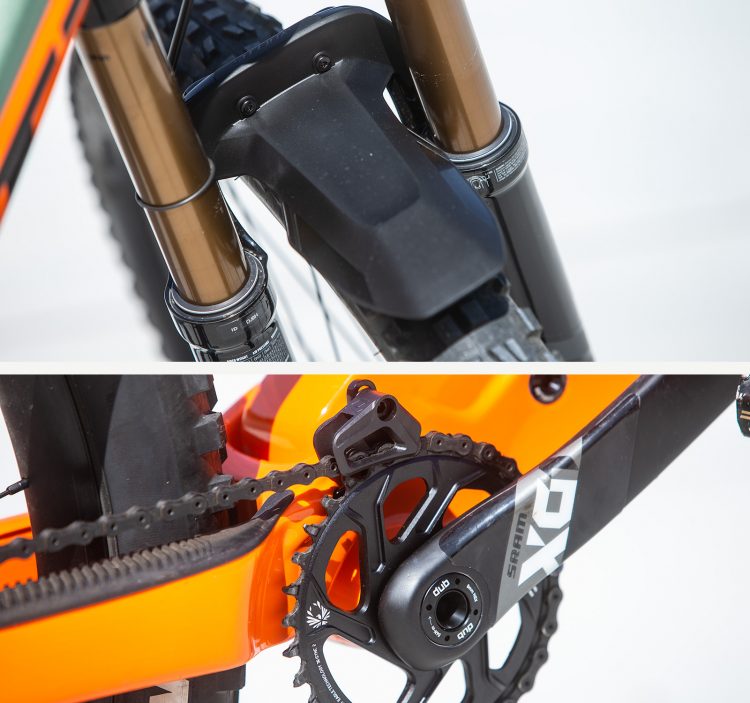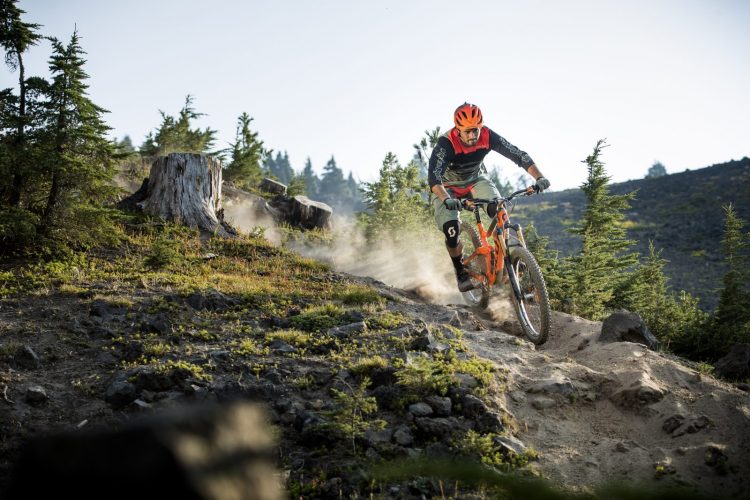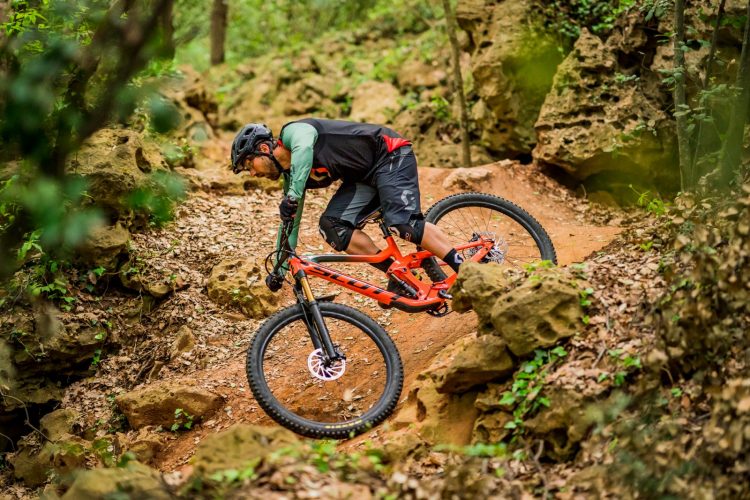Who remembers the first Scott Ransom, launched in the now distant 2006? 2018 marks the return of a bike that, at the time, had aroused much interest, but today it does so by adapting to 29-inch wheels, although it is compatible with 27.5″ wheels as well.
Before the official presentation, Scott sent us the 900 Tuned model to test out on our home trails. It’s the top of the line 29 “version of the brawny brawler.
The Scott Ransom 900 Tuned in summary
- Frame material: Carbon fiber
- Wheel size: 29 “(max 2.6” tires), also available in 27.5 “
- Suspension layout: Four bar with Horst link
- Variable geometry: yes
- Front/rear travel: 170/170 mm. Rear drops to 120mm in Traction position
- Rear Boost: yes
- Fork Boost: yes / offset 44 mm
- Metric shock: yes, Trunnion mount
- Tubeless wheels and tires: yes
- Transmission: Eagle 1 × 12 with 32T ring
- Derailleur attachment: no
- ISCG mount: no
- Bottle holder: yes
- Frame only availability: no
- Weight – M: 13.13 kg
- Complete provisory bike price: 7.499 euros
Geometry
The bike on test was a size medium. The Low Settings refer to 29, the High Settings to 27.5. The frame is the same.
Scott chose a very modern geometry, with a head tube angle of 64.5°, a steep seat angle at 75º, a reasonably long reach – 439.5mm, and a shorter fork offset, 44mm. In short, Transition’s Speed Balance Geometry has taken the bike world by storm, and even the Swiss brand is convinced of its validity.
The variable geometry from the upper shock mount’s flip chip is designed to accept both 27.5 “or 29” wheels without having to change anything else and keeping the bottom braket height the same.
What’s unique about the Ransom is its adjustment of the rear travel from 170 to 120mm when you switch to the Traction position of the Nude TR Evol via the remote TwinLoc. By decreasing the size of the positive chamber, the sag is reduced and with this you also effectively change the geometry, which becomes more efficient while climbing.
Static analysis
Scott has always built carbon bikes with the aim of keeping them light. In this case, however, they had an eye on sturdiness, given that with 170mm of travel, the Ransom belongs to a category of mountain bikes that allows you to go at very high speeds downhill on really rowdy terrain. The bottom bracket area, for example, is very massive and 9 mm wider than the smaller sister, the Genius. The press fit will make some people turn up their noses, but it is a choice that’s also found on plenty of competing products (such as the new Yeti SB150), as it nods toward greater torsional rigidity compared to threaded bottom brackets.
There is no front derailleur attachment: the Ransom was designed for single ring drivetrains, which allowed Scott engineers to work on the rigidity at the bottom bracket area, as it gave them more space to play with.
The heart of the whole bike, if you can call it that, is the Fox Nude TR shock absorber. In addition to the aforementioned possibility to decrease the travel via remote control, the real innovation lies in the “Ramp” lever. This allows you to increase or decrease the progressiveness in the blink of an eye, without having to open up the shock, using internal volume spacers. The mechanism behind this feature provides for a decrease in the volume of the additional positive chamber (the one that comes into play when Twinloc is open), when you turn the lever towards “Ramp +”.
One has to wonder why no one hadn’t thought of this before, since this function is a godsend when adapting the shock to the varying types of descents that you go on. I asked Fox if we will find this lever on other products, but I’m still waiting for an answer. The activation of the lever is simple, and easy to reach.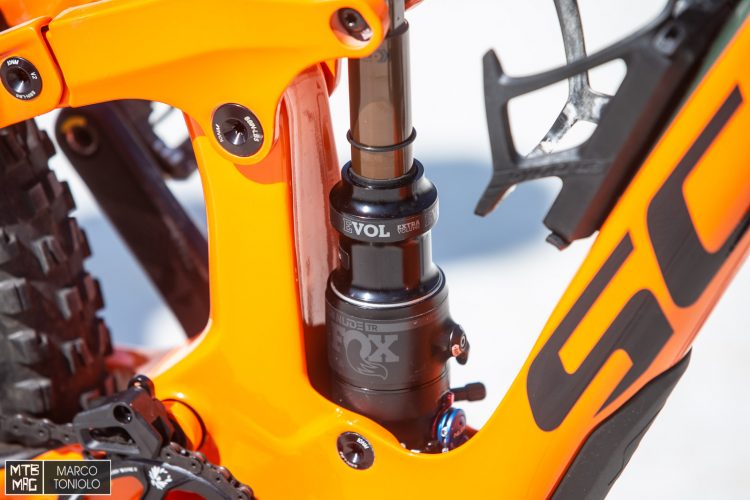
In the picture below, you can see below the knob for the choice of the three positions Locked, Traction, Dowhnill, attached to the remote handlebar and controlled by a steel cable that passes inside the frame. The remote also controls the compression of the fork, in sync with the shock. Being a Fox 36, there is no reduction of travel in the Traction position, but rather a firming of the compression. When open, the low speed compression of the 36 can be adjusted with 21 clicks via an external knob.
The suspension layout is a four-bar with a Horst link that drives a very short and robust rocker arm. The whole rear end gives off the impression that it is quite stout, which was later confirmed in the field test.
It is no secret that Scott loves high volume tires, so it was no surprise that they chose them for the Ransom 900. To be exact, 2.6 ” Maxxis Minion DHF tires with a 120TPI Kevlar Bead, EXO TR 3C Maxx Terra, both front and rear, set up tubeless on Synchros “Revelstoke” aluminum wheels with a 30mm internal rim diameter. 2.6 “is also the maximum compatible size on 29, as you can see from the photos, while on 27.5” you should be able to get up to 2.8 “. I will come back to the robustness of these tires.
The transmission is a 1×12 SRAM XO1 Eagle with a 32 tooth front chainring. The brakes are also from SRAM: Code RSC with 200 and 180mm discs on the front and rear respectively. The chain guide is Scott’s house brand and is fixed to the main pivot, as there is no ISCG connection.
Regarding the shape of the frame, and in particular the lower part of the down tube, you can see how it is rather long and flat. Lately several bikes have this feature, to room for the bottle. Anticipating the results of the test, there are no problems whatsoever for which the tube would bump into the ground or obstacles before the chainring. In any case, the plastic protection is massive and extended over the most exposed part.
The cable routing is completely internal and the holes in the frame are sufficiently generous to not interfere too much when maintenance is required. The cables do not flap because they are well fixed. Overall, the whole bike is very quiet, thanks to the very soft chainstay protection.
There is an interesting cockpit and fenders mounted on the FOX 36, both from Syncros Scott’s house brand. The handlebar with its integrated stem is carbon fiber – 780mm wide, with a rise of 20mm, but above all an 8º backsweep, very pronounced. On the left side we find the Twinloc, whose handlebar mount also acts as a collar and remote control for the Fox Transfer dropper post. A clean solution, but one that still requires you to remove the thumb from the handlebar to lower or raise the saddle.
It is worth reiterating that a weight of only 13.13 kg without pedals is truly remarkable for a 29-inch 170mm travel bike.
On the trail
Riding a Scott takes time to adapt to the handlebar controls. On the Ransom, even if the Twinloc is the least bulky and the most ergonomic possible, it is necessary to get used to having the remote control of the dropper post above the bars, especially for those who haven’t used a 2x drivetrain for a long time. At the beginning of the test several times I happened to accidentally hit the Twinloc instead of the seat post, but after a while I got used to it and the movements came naturally. I admit, however, that pushing down the remote of the Transfer is tricky, especially in the excitement of a trail done at full speed, because you have to detach the thumb from the handlebars and use some strength to operate it. The leverage you have is in fact pretty low, because the lever is short.
Climbing
That said, if you lock the suspension, the Ransom is easy to grind along on, despite the generously sized tires. Both the fork and the shock are still as you could imagine. The feeling and efficient power transfer from the pedals to the ground is something I’ve found only on Scott bikes, thanks to the Twinloc.
If the terrain becomes uneven, the Twinloc in the Traction position decreases the shock travel to 120mm, another nice windfall. Not only because 170mm of travel on a four bar with Horst means a fair amount of bobbing, but above all due to the fact that, upon decreasing the sag, the pedaling position is more upright, while still maintaining enough travel necessary to have the right traction when needed. At the front, the fork firms up slightly, still offering the needed sensitivity when riding off-road.
Climbing the Maxxis Minion DHF 2.6″ has only advantages, especially if you don’t climb paved roads and you do climb in rough terrain. The traction is really noticeable when you inflate them to the right pressure, which for me is between 1.3 and 1.4. bar. It is easier to overcome loose sections, thanks to the generous footprint on the ground, and I must say that, combined with the 75° seat angle, I managed to climb everywhere nicely despite the very lax head angle angle. We will never tire of saying that the 29ers with modern geometry are very versatile, more than what the travel and the angles make us think at first. The variable variable travel at the rear, helps place the Ransom at the top of the ranks of the best climbers among the long travel 29 crowd (we still have to test the Cannondale Jekyll 29, which has a similar system).
Speaking of sizes, the Medium for me at 179cm tall proved to be perfect. You are sitting rather compact, so if you are used to long bikes perhaps you’d want to size up – in this case the Large.
Descending
You know when you buy a new bike and suddenly you feel Superman? Well, that was the feeling that I had during my first outings with the new Ransom. This bike is a downhill monster. Clearly, the 170mm travel helps, but it’s not just that. First of all, you are riding a very rigid and precise frame, and you feel it in the first corners and line choices. But what jumps out more is just how well the suspension works. I had some doubts when I noticed that the FOX Nude TR did not have a piggyback, because on a bike of this excursion I expected to see something similar to the X2. I must also say that its dimensions are reminiscent of those of the X2, so we are not talking about a miniature shock, indeed. It is very sensitive and perfectly matches the behavior of the rear triangle, rather linear. I already hear the comments on the bottom outs, and block them in the bud: I had a single bottom out during the whole test, when I was riding with the lever of the Ramp placed on the side “less”. From that moment on I left it almost always on the “more”, and here is that the progressivity increases without walling, giving the bike a feeling of infinite travel that I really liked.
You now ask yourself what the Ramp lever is for if I have almost always left it on the +. Exactly, almost . When I knew I was going to a slow and technical section, I would turn it around – and here I could make the most of the ride, keeping the rear end quiet even on the biggest steps. In short, the possibility to choose is there and it’s nice to use it also depending on tracks you are going to travel to, depending on personal taste. If it were up to me, I would love to see it on all the rear shocks on the market.
The other factor that helps make the Ransom a descending monster is its geometry. Reduced offset, and a slack head angle: on the fast rough bits, one limitation is the rear tire, but more on that in a moment. In the tight sections, I managed the bike in the corners very easily. 437mm chainstays and a 75° seat angle compensate for what is an open front end, but we have already talked about this, particularly in the Transition Sentinel test, which has very similar geometry.
We come to the tires: I liked them a lot on the uphills, but I have a problem with them on the downhills, especially at the rear (note the 120 TPI casing). I did the “test Tamaro”, ie I took the Ransom on my home track with the most nasty rocks in the area (from 1800 to 400 meters of altitude, 14 km of descending), keeping them at the usual pressure of 1.4 bar. At the rear the Minion DHF 2.6″ resisted for 500 meters, then I pinched, cutting it just above the bead, and on the shoulder near the rim. When plugged it, I continued, being more careful with my line choice, which however is a bit of a pity, because with the Ransom, one of the good things is just to get rid of the normal lines and point the bike where ever you want. In any case, the front 2.6″ has held up and, as far as uphills went, the tire wae excellent in terms of grip and traction.
The day after, I changed tires, mounting two 2.35″ tires with sturdy casings (along the lines of the Schwalbe Supergravity), and let the Ransom run on all kinds of rough stuff, without pinching. For me this is the best solution for the type of bike, also because the weight remained almost unchanged.
Summarizing, the character of the Ransom strikes a nice balance between plowing and playing: getting the bike up and over obstacles is really quite a breeze, but it will stay glued to the ground in the roughest terrain without flinching.
Conclusions
The new Ransom 29 is the best Enduro ever produced by Scott, because it combines the upward efficiency of the Twinloc system with the quality of a well thought out enduro with modern geometry. The Nude TR shock with the Ramp lever proved to be a great novelty, both for its sensitivity and for the possibility of adapting the progressivity to personal tastes and needs – on the fly. Given the speeds being reached downhill, we’d recommend switching to more robust tires, if nothing else at the rear.
Spec Levels
